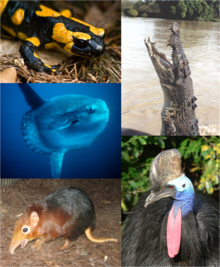Euteleostomi
| Euteleostomes | |
|---|---|

| |
| Individual organisms from each major Euteleostomi group. Clockwise, starting from top left:
Fire salamander (Amphibia), saltwater crocodile (Reptilia), southern cassowary (Aves), black-and-rufous giant elephant shrew (Mammalia), ocean sunfish (Osteichthyes) | |
| Scientific classification | |
| Kingdom: | Animalia |
| Phylum: | Chordata |
| Clade: | Teleostomi |
| Clade: | Euteleostomi |
| Subgroups | |
Euteleostomi is a successful clade that includes more than 90% of the living species of vertebrates. Euteleostomes are also known as "bony vertebrates". Both its major subgroups are successful today: Actinopterygii includes most extant fish species, and Sarcopterygii includes the tetrapods.
"Osteichthyes" in the sense of "bony vertebrates" is synonymous with Euteleostomi,[1] even though in Linnaean taxonomy the name (literally meaning "bony fish") traditionally referred to the paraphyletic group with the exclusion of tetrapods.[2] The name Euteleostomi was coined as a monophyletic alternative that unambiguously includes the living tetrapods and is widely used in bioinformatics.[3]
The term Euteleostomi comes from Eu-teleostomi, where Eu- comes from Greek εὖ 'well, good', so the clade can be defined as the living teleostomes.
Euteleostomes originally all had endochondral bone, fins with lepidotrichs (fin rays), jaws lined by maxillary, premaxillary, and dentary bones composed of dermal bone, and lungs. Many of these characters have since been lost by descendant groups, however, such as lepidotrichs lost in tetrapods, and bone lost among the chondrostean fishes. Lungs have been retained in dipnoi (lungfish), and many tetrapods (birds, mammals, reptiles, and some amphibians). In many ray-finned fishes, lungs have evolved into swim bladders for regulating buoyancy, while in others they continue to be used as respiratory gas bladders.[4][5][6]
Classification[]
Euteleostomi contains the following subgroups:
- Actinopteri
- Cladistia
- Polypteriformes
- Actinistia
- Coelacanthiformes
- Dipnoi
- Ceratodontimorpha
- Tetrapodomorpha
References[]
- ^ Nelson, Joseph (2007). Fishes of the World. John Wiley & Sons. p. 86. ISBN 978-0-471-75644-6.
- ^ Cracraft, Joel; Donoghue, Michael J. (25 April 2019). Assembling the Tree of Life. Academic Press. p. 396. ISBN 978-0-19-972960-9.
- ^ Berman, Jules (25 June 2004). Evolution's Clinical Guidebook. Oxford University Press. p. 215. ISBN 0-12-817127-8. Retrieved 14 May 2015.
- ^ Clack, Jennifer A. (27 June 2012). Gaining Ground, Second Edition: The Origin and Evolution of Tetrapods. Indiana University Press. pp. 21–4. ISBN 978-0-253-00537-3. Retrieved 12 May 2015.
- ^ Longo, Sarah; Riccio, Mark; McCune, Amy R (2013). "Homology of lungs and gas bladders: Insights from arterial vasculature". Journal of Morphology. 274 (6): 687–703. doi:10.1002/jmor.20128. ISSN 0362-2525. PMID 23378277. S2CID 29995935.
- ^ R. McCune, Amy; C. Schimenti, John (2012). "Using Genetic Networks and Homology to Understand the Evolution of Phenotypic Traits". Current Genomics. 13 (1): 74–84. doi:10.2174/138920212799034785. ISSN 1389-2029. PMC 3269019. PMID 22942677.
External links[]
- Euteleostomi
- Vertebrate taxonomy
- Teleostomi
- Pridoli first appearances
- Extant Silurian first appearances
- Vertebrate stubs